Research - (2022) Volume 10, Issue 1
Prevalence of Rheumatoid Symptoms in Females of More Than 40 Years-A Survey
K Helen Reshma, Palati Sinduja* and Priyadharshini R
*Correspondence: Palati Sinduja, Department of Pathology, Saveetha Institute of Medical and Technical Sciences, Saveetha University, India, Email:
Abstract
Introduction: Rheumatoid arthritis is an autoimmune disorder where the immune system attacks the own healthy cells thereby causing inflammation in the affected parts of the body. It initially affects smaller joints of the body. Severe forms of rheumatoid arthritis can even cause physical disabilities. Signs and symptoms of rheumatoid arthritis include pain in joints, swollen joints, and joint stiffness. Fever and fatigue may be present. Other symptoms start to appear in a week or month. It usually occurs in middle age and duration is lifelong and sometimes the causes are unknown. It is treated most often with steroids, Nonsteroidal anti-inflammatory drugs. Aim: To determine the prevalence of rheumatoid symptoms in females of more than 40 years. Materials and Methods: Well-structured questionnaire containing 14 self-structured questions was framed and circulated among 50 women above 40 years of age through an online survey link. Descriptive statistics was carried out using SPSS software. . Results: The majority of women aged 40 to 50 years suffer from fatigue. Pearson’s Chi-square value: 4.303, p value- 0.36 (p>0.05), hence statistically not significant. The results conclude that the prevalence of rheumatoid symptoms is less among the women and very few early symptoms are seen among them. Conclusion: In this study, the prevalence of rheumatoid symptoms was seen less among women above 40years of age. Further studies can be done to check the progression of symptoms.
Keywords
Rheumatoid, Arthritis, Women, Joint swelling, Innovative technique
Introduction
Rheumatoid arthritis is an autoimmune disorder and an inflammatory disease in which the immune system by mistake attacks the healthy cells thereby causing inflammation in the affected parts of the body [1]. It is a chronic inflammatory disease that initially affects smaller joints of the body where the initial symptoms start to appear. In mild conditions, it affects the lining of joints and causes painful swelling which leads to bone erosion and deformities in the joint [2]. Severe forms of rheumatoid arthritis can even cause physical disabilities. Signs and symptoms of rheumatoid arthritis include pain in joints, swollen joints, and joint stiffness. Wrists and hands are the most commonly involved parts and it may also affect other parts resulting in low red blood cell count, inflammation around the lungs and heart [3]. Fever and fatigue may be present [4]. Other symptoms start to appear in a week or month. It usually occurs in middle age and duration is lifelong and sometimes the causes are unknown. It is treated most often with steroids, non-steroidal antiinflammatory drugs [5].
The cause is unknown but it may also occur due to genetic and environmental factors. As it is an autoimmune disease, the immune system of the body attacks the joints that result in inflammation, thickening of the joint capsule, and affects underlying bone and cartilage [6]. Diagnosis is done by X-rays and lab tests. Treatment involves reducing the pain and inflammation and helps in improving a person's overall functions. Drugs like methotrexate and hydroxychloroquine slow the progression of the disease. Surgeries are done in certain cases. Cardiovascular disease, osteoporosis, cancer, infection and mental difficulties are associated problems [7]. Many women are not aware of the symptoms and thus it leads rheumatoid to severe form. This study reveals the prevalence of rheumatoid among women and also provides knowledge on its symptoms, treatment and prevention.
Inflammation of the synovial membrane is characteristic of joint arthritis. Joint swells and stiffens and limits the movements. Small joints such as hands, feet, cervical spine and larger joints such as shoulder and knee are involved. Inflammation of the joints and pain are commonly seen early in the morning on waking and prolonged inactivity [8]. Stiffness increases early in the morning and lasts for an hour. Gentle movements can relieve the symptoms in the early stage of the disease [9]. These signs help distinguish rheumatoid from osteoporosis which is a non-inflammatory problem of the joint [10]. Progression of the disease leads to erosion and destruction of the joint and thus leads to deformities. In severe cases it is known as arthritis mutilans, mutilating nature of the deformities [11]. Lung fibrosis is a complication of rheumatoid arthritis. Atherosclerosis, Myocardial infarction and stroke is also a complication of rheumatoid arthritis. Other complications include endocarditis, pericarditis, left ventricular failure, valvulitis and fibrosis [12]. Cardiovascular risk can be controlled by exercises, medications and reducing the inflammation caused by rheumatoid arthritis. The chronic inflammation caused by rheumatoid arthritis leads to anaemia of chronic disease. Iron is poorly absorbed and when inflammation is uncontrollable platelet count increases. Renal amyloidosis occurs in untreated chronic inflammation. Osteoporosis occurs in rheumatoid arthritis around the inflamed joints. In the oral cavity, tooth loss and periodontitis are seen in people with rheumatoid arthritis [13].
Family history of rheumatoid arthritis increases the risk as the major histocompatibility complex (MHC) antigen is strongly associated with rheumatoid arthritis. Smoking is a risk factor for rheumatoid arthritis. Rheumatoid primarily starts with cellular activation leading to autoimmunity in joints and other organs. Progression of rheumatoid is associated with three phases: initiation phase, amplification phase and chronic inflammatory phase and tissue injury [14].
Hand and feet X Rays are done when many joints are affected. MRIs are also used. In clinical suspicion of rheumatoid, a test for rheumatoid factor is done. This cannot be prevented but only the risk factors can be reduced. Regular exercise helps in maintaining muscle strength and overall physical function [15]. This study has been conducted in the form of a survey to know about symptoms and prevalence of rheumatoid among women which has not been done previously in any research [16]. Our team has extensive knowledge and research experience that has translated into high quality publications [17–35]. The study aims to determine the prevalence of rheumatoid symptoms in females of more than 40 years.
Materials and Methods
Study setting
The present study was a prospective online questionnaire based observation survey conducted among the women from a metropolitan city of India. The participants were recruited using the convenience sampling due to the presence of lock down placed by the government. Structured questionnaire was developed after deliberation among the authors and taking into account the research question. Structured questionnaire consisted of 14 self-explanatory questions. Final structured questionnaire was converted into an online survey form using Microsoft Google form. The Google form was sent to prospective participants and was asked to provide a response for each of the questions. The participants were contacted through phone after sending the online form as well as in case of delay in response. The study was approved by the Institutional review board.
Patient selection and recruitment
The study was conducted according to the helsinki declaration and privacy of participants was maintained. The study consisted of 50 women of age above 40 years. Individuals who were not willing were excluded from our study. The sample size was calculated using G-power analysis.
Development of questionnaire
The survey consists of 14 self-administered questionnaires. Questions were prepared by referring to other literature that represented the symptoms of rheumatoid among women. All the questions are of multiple choices.
Survey (data collection)
This was conducted through an online survey in one month in February 2021. The responses were collected in the goggle sheet and tabulated. The results were obtained and analysed using statistical analysis. The survey was to create and gather data among heterogeneous populations. A simple random sampling link was done to eliminate response bias. Measures taken for minimising errors are internal and external validity.
Statistical analysis
The descriptive statistics were done using IBM SPSS V22 software. Gender and age were dependent variables and knowledge, perception were independent variables. Chisquare analysis was performed for gender association and p<0.05 was considered as statistically significant. The statistical test used was the chi square test.
Results
The response rate for questionnaire study was 100%. All the respondents answered all the questions. 64.71%, 17.65% and 17.65% of participants were from 40-50 years, 50-60, and above 60 years of age respectively. 56.86% of participants reported reduction in morning stiffness after mild exercise whereas in case of 43.14% of the participants morning stiffness did not reduce after mild exercise. 19.61%, 17.65% and 62.75% of the participants have joint swelling <1 month, >6 months and >1 year respectively. 41.18% of the participants have fatigue and 58.82% do not have fatigue. 13.73% of the participants had weight loss and 86.27% did not have weight loss. 49.02% of the participants had a fever and 50.98% did not have a fever. 3.92%, 50.98% and 45.10% of the participants lost <20 kgs, did not lose weight and <10 kgs respectively. 60.78% of the participants have irritation in their eyes and 39.22% do not have irritation in their eyes. 41.18% of the participants have dry mouth and 58.82% do not have dry mouth.
Impairment in vision and irritation in the eyes were the most frequent symptoms reported among the women of this present study. Other symptoms of fatigue, fever, joint swelling were very less reported among the participants (Figures 1-7).
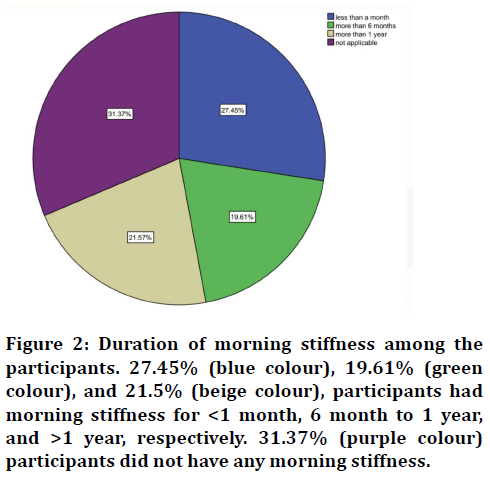
Figure 1. Response of participants when asked about morning stiffness. 66.67 %( blue colour) of participants reported morning stiffness whereas 33.33% (green colour) of participants do not.
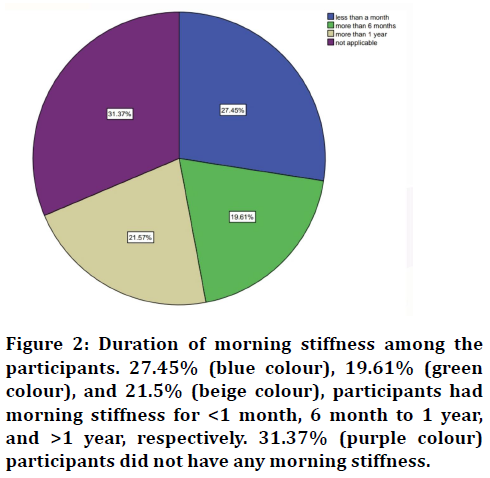
Figure 2. Duration of morning stiffness among the participants. 27.45% (blue colour), 19.61% (green colour), and 21.5% (beige colour), participants had morning stiffness for <1 month, 6 month to 1 year, and >1 year, respectively. 31.37% (purple colour) participants did not have any morning stiffness.
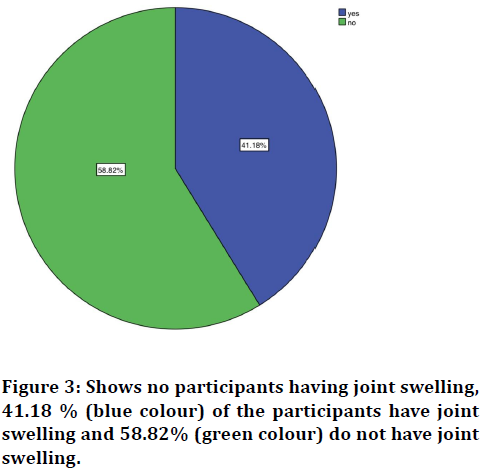
Figure 3. Shows no participants having joint swelling, 41.18 % (blue colour) of the participants have joint swelling and 58.82% (green colour) do not have joint swelling.
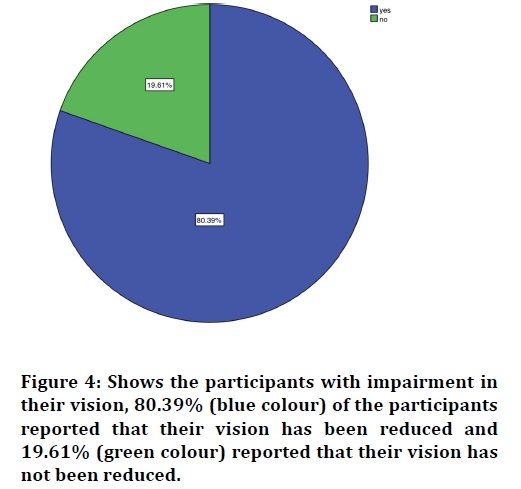
Figure 4. Shows the participants with impairment in their vision, 80.39% (blue colour) of the participants reported that their vision has been reduced and 19.61% (green colour) reported that their vision has not been reduced.
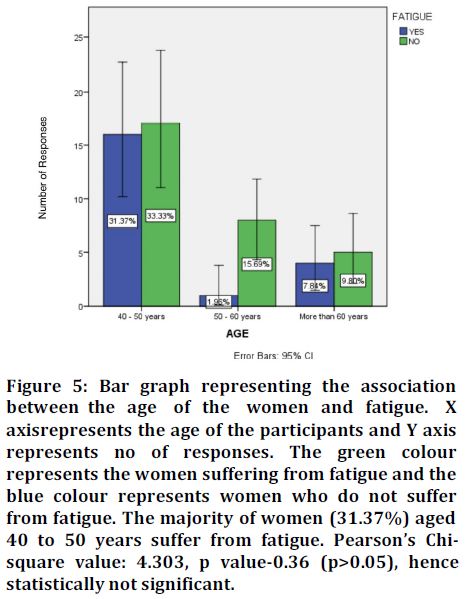
Figure 5. Bar graph representing the association between the age of the women and fatigue. X axis represents the age of the participants and Y axis represents no of responses. The green colour represents the women suffering from fatigue and the blue colour represents women who do not suffer from fatigue. The majority of women (31.37%) aged 40 to 50 years suffer from fatigue. Pearson’s Chisquare value: 4.303, p value-0.36 (p>0.05), hence statistically not significant.
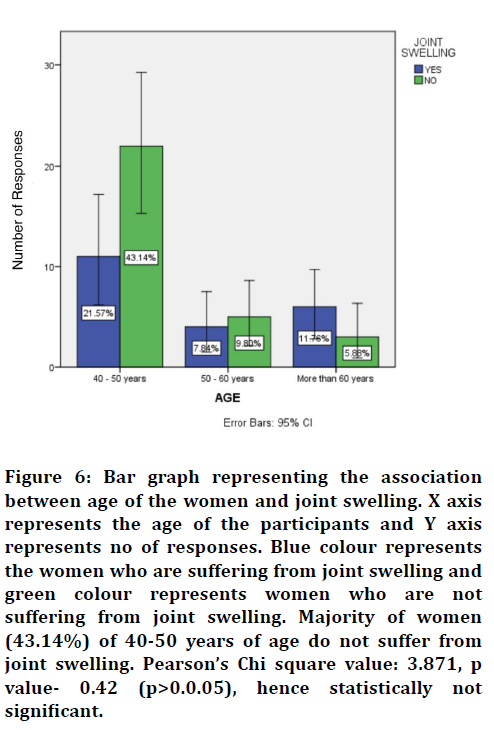
Figure 6. Bar graph representing the association between age of the women and joint swelling. X axis represents the age of the participants and Y axis represents no of responses. Blue colour represents the women who are suffering from joint swelling and green colour represents women who are not suffering from joint swelling. Majority of women (43.14%) of 40-50 years of age do not suffer from joint swelling. Pearson’s Chi square value: 3.871, p value- 0.42 (p>0.0.05), hence statistically not significant.
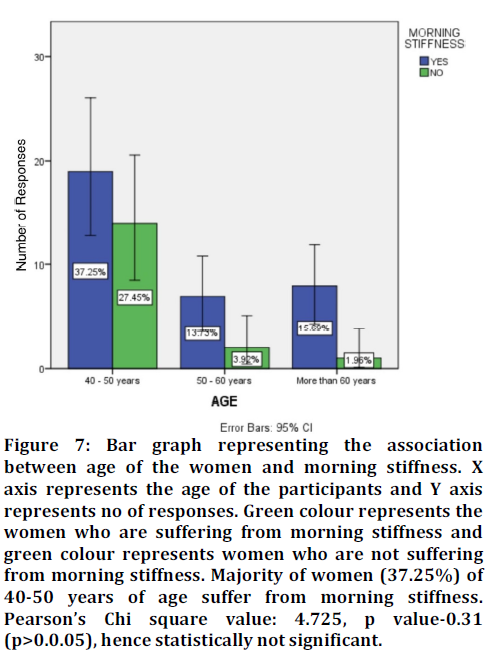
Figure 7. Bar graph representing the association between age of the women and morning stiffness. X axis represents the age of the participants and Y axis represents no of responses. Green colour represents the women who are suffering from morning stiffness and green colour represents women who are not suffering from morning stiffness. Majority of women (37.25%) of 40-50 years of age suffer from morning stiffness. Pearson’s Chi square value: 4.725, p value- 0.31 (p>0.0.05), hence statistically not significant.
Discussion
In this present study impairment and eye irritation was most reported by the participants. In a study conducted by Nicklin et.al 7 out of 15 participants had fatigue, whereas in this present study 41% of the participants have fatigue. Participants were unable to continue their daily tasks and lack of enthusiasm was present among them. Duration of the fatigue varied from short to permanent fatigue. Due to fatigue, participants felt a lack of energy, their social life became limited and they were unable to accomplish what they wanted to do [36]. In a study conducted by England et.al it was found that weight loss is one of the predictors of cause specific mortality in rheumatoid. In this present study 13.73% of the participants had weight loss and 86.27% of the participants did not have weight loss [37]. In a study conducted by Punjabi et.al 27% of the participants had dry eyes as a risk factor of rheumatoid. In this present study 60.78% of the participants have irritation in their eyes and 39.22% of the participants do not have irritation in their eyes. Rheumatoid in Indian population have a significantly high rate of dry eyes and irritation in the eyes [38]. In South India there is a high prevalence of dry eye disease and irritation in the eye among rheumatoid arthritis patients [39]. In a study conducted by Wolfe et.al, ocular and oral dryness is increased in rheumatoid arthritis [40]. In this present study 41.18% of the participants have dry mouth and 58.82% of the participants do not have dry mouth.
In a study conducted by Kaur et.al and Singh et.al, diminished acuity of vision was the most frequent symptom encountered. In a study conducted by Shah Et.al, reported that muscle and joint pain was as high as 37.4%. In a study conducted by Chopra et.al, back pain and painful neck was seen in 17.3% of men and 9.5% of women, respectively. In a study conducted by Dai et.al, reported knee to be the most common site seen in 7.0% of women followed by lower back (5.6%), shoulder (4.7%) and neck (2.4%). Haq et.al, reported that the most commonly affected sites are knees, hips and shoulders.
This study has certain limitations. The study sample size was small which could have some impact on the result of the study. In addition some of the symptoms were not included on the questionnaire. Since it was an online questionnaire survey, it is possible that some of the participants may not have reported properly. Future studies with a large cohort are wanted to know the prevalence of signs and symptoms on rheumatoid arthritis in women.
Conclusion
Rheumatoid symptoms are less prevalent among women of above 40 years of age. Only the risk factors can be reduced in rheumatoid and there is no prevention for this condition. Regular exercises are recommended as higher levels of physical activity is associated with reduced risk of rheumatoid and educational approaches and camps on rheumatoid help in knowledge about rheumatoid symptoms and its complications. With proper diet and exercise, risk factors and early symptoms of rheumatoid can be reduced.
Acknowledgements
The authors are thankful to Saveetha Institute of Medical and Technical Sciences, Saveetha Dental College and Hospitals, Saveetha University for giving a platform to conduct the study.
Conflict of Interest
The authors would like to declare no conflict of interest in the present study.
Funding
The present project is supported by:
Saveetha Dental College and Hospitals, Saveetha University, Saveetha Institute of Medical and Technical Sciences.
Wings Decors and Cattering, Madurai.
References
- Gallez P le, le Gallez P. Rheumatoid arthritis. Nursing Standard 1994; 9: 33â??40.
- Taylor PC. Update on the diagnosis and management of early rheumatoid arthritis. Clin Med 2020; 20: 561â??4.
- Smolik I, Robinson DB, Bernstein CN, et al. First-degree relatives of patients with rheumatoid arthritis exhibit high prevalence of joint symptoms. J Rheumatol 2013; 40:818-24.
- Rupp I, Boshuizen HC, Jacobi CE, et al. Impact of fatigue on healthâ?related quality of life in rheumatoid arthritis. Arthritis Care Res 2004; 51:578-85.
- Firth J. Rheumatoid arthritis: Diagnosis and multidisciplinary management. Br J Nurs 2011; 20:1179-85.
- Kaushik P, Kaushik R. Diagnosis and management of rheumatoid arthritis. Am J Med 2008; 121:e7.
- Majithia V, Geraci SA. Rheumatoid arthritis: Diagnosis and management. Am J Med 2007; 120:936-9.
- Katz PP. The impact of rheumatoid arthritis on life activities. Arthritis Rheumatol 1995; 8:272-8.
- Neuberger GB, Press AN, Lindsley HB, et al. Effects of exercise on fatigue, aerobic fitness, and disease activity measures in persons with rheumatoid arthritis. Res Nurs Health 1997; 20:195-204.
- Hall AM, Copsey B, Williams M et al. Mediating effect of changes in hand impairments on hand function in patients with rheumatoid arthritis: exploring the mechanisms of an effective exercise program. Arthritis Care Res. 2017;69:982-8.
- van Zeben D, Hazes JM, Zwinderman AH et al. Clinical significance of rheumatoid factors in early rheumatoid arthritis: Results of a follow up study. Ann Rheum Dis 1992; 51:1029-35.
- Pappas DA, Giles JT, Connors G, et al. Respiratory symptoms and disease characteristics as predictors of pulmonary function abnormalities in patients with rheumatoid arthritis: An observational cohort study. Arthritis Res Ther 2010; 12:1-1.
- Katz WA. Modern management of rheumatoid arthritis. Am J Med 1985; 79:24-31.
- Chan KW, Felson DT, Yood RA, et al. The lag time between onset of symptoms and diagnosis of rheumatoid arthritis. Arthritis Rheumatism 1994; 37:814-20.
- Neuberger GB, Aaronson LS, Gajewski B, et al. Predictors of exercise and effects of exercise on symptoms, function, aerobic fitness, and disease outcomes of rheumatoid arthritis. Arthritis Care Res 2007; 57:943-52.
- Anita R, Paramasivam A, Priyadharsini JV, et al. The m6A readers YTHDF1 and YTHDF3 aberrations associated with metastasis and predict poor prognosis in breast cancer patients. Am J Cancer Res 2020; 10:2546â??54.
- Jayaseelan VP, Paramasivam A. Emerging role of NET inhibitors in cardiovascular diseases. Hypertens Res 2020; 43:1459â??61.
- Sivakumar S, Smiline Girija AS, Vijayashree Priyadharsini J. Evaluation of the inhibitory effect of caffeic acid and gallic acid on tetR and tetM efflux pumps mediating tetracycline resistance in Streptococcus sp., using computational approach. J King Saud Univ Sci 2020; 32:904â??909.
- Smiline Girija AS. Delineating the immuno-dominant antigenic vaccine peptides against gacs-sensor kinase in Acinetobacter baumannii: An in silico investigational approach. Front Microbiol 2020; 11:2078.
- Iswarya Jaisankar A, Smiline Girija AS, Gunasekaran S et al. Molecular characterisation of csgA gene among ESBL strains of A. baumannii and targeting with essential oil compounds from Azadirachta indica. J King Saud Univ Sci 2020; 32:3380â??7.
- Girija AS. Fox3+ CD25+ CD4+ T regulatory cells (Tregs) may transform the n-CoV's final destiny to CNS!. J Med Virol 2020.
- Jayaseelan VP, Ramesh A, Arumugam P. Breast cancer and DDT: Putative interactions, associated gene alterations, and molecular pathways. Environ Sci Pollut Res Int 2021; 28:27162â??73.
- Arumugam P, George R, Jayaseelan VP. Aberrations of m6A regulators are associated with tumorigenesis and metastasis in head and neck squamous cell carcinoma. Arch Oral Biol 2021; 122:105030.
- Kumar SP, Girija AS, Priyadharsini JV. Targeting NM23-H1-mediated inhibition of tumour metastasis in viral hepatitis with bioactive compounds from ganoderma lucidum: A computational study. Indian J Pharm Sci 2020; 82:300-5.
- Girija SA, Priyadharsini JV, Paramasivam A. Prevalence of carbapenem-hydrolyzing OXA-type β-lactamases among Acinetobacter baumannii in patients with severe urinary tract infection. Acta Microbiol Immunol Hung 2019; 67:49â??55.
- Priyadharsini JV, Paramasivam A. RNA editors: Key regulators of viral response in cancer patients. Epigenomics 2021; 13:165â??7.
- Mathivadani V, Smiline AS, Priyadharsini JV. Targeting epstein-barr virus nuclear antigen 1 (EBNA-1) with murraya koengii bio-compounds: An in-silico approach. Acta Virol 2020; 64:93â??9.
- Girija S, Priyadharsini JV. Prevalence of Acb and non-Acb complex in elderly population with urinary tract infection (UTI). Acta Clin Belg 2021; 76:106â??12.
- Anchana SR, Girija SAS, Gunasekaran S, et al. Detection of csgA gene in carbapenem-resistant Acinetobacter baumannii strains and targeting with Ocimum sanctum biocompounds. Iran J Basic Med Sci 2021; 24:690â??8.
- Girija ASS, Shoba G, Priyadharsini JV. Accessing the T-cell and B-cell immuno-dominant peptides from A. baumannii biofilm associated protein (bap) as vaccine candidates: A computational approach. Int J Pept Res Ther 2021; 27:37â??45.
- Arvind TR, Jain RK. Skeletally anchored forsus fatigue resistant device for correction of Class II malocclusions-A systematic review and meta-analysis. Orthod Craniofac Res 2021; 24:52â??61.
- Venugopal A, Vaid N, Bowman SJ. Outstanding, yet redundant? After all, you may be another Choluteca Bridge! Semin Orthod 2021; 27:53â??6.
- Ramadurai N, Gurunathan D, Samuel AV et al. Effectiveness of 2% Articaine as an anesthetic agent in children: Randomized controlled trial. Clin Oral Investig 2019; 23:3543â??50.
- Varghese SS, Ramesh A, Veeraiyan DN. Blended module-based teaching in biostatistics and research methodology: A retrospective study with postgraduate dental students. J Dent Educ 2019; 83:445â??50.
- Mathew MG, Samuel SR, Soni AJ et al. Evaluation of adhesion of Streptococcus mutans, plaque accumulation on zirconia and stainless steel crowns, and surrounding gingival inflammation in primary molars: Randomized controlled trial. Clin Oral Investig 2020; 24:3275-80.
- Nicklin J, Cramp F, Kirwan J, et al. Collaboration with patients in the design of patient-reported outcome measures: Capturing the experience of fatigue in rheumatoid arthritis. Arthritis Care Res 2010; 62:1552â??8.
- England BR, Baker JF, Sayles H, et al. Body mass index, weight loss, and cause-specific mortality in rheumatoid arthritis. Arthritis Care Res 2018; 70:11â??8.
- Punjabi OS, Adyanthaya RS, Mhatre AD, et al. Rheumatoid arthritis is a risk factor for dry eye in the Indian population. Ophthalmic Epidemiol 2006; 13:379â??84.
- Huda R, Waris SAN, Swamy Raj SV, et al. Rheumatoid arthritis is a risk factor for dry eye in south Indian population. Int J Ocul Oncol 2019; 5: 31â??3.
- Wolfe F, Michaud K. Prevalence, risk, and risk factors for oral and ocular dryness with particular emphasis on rheumatoid arthritis. J Rheumatol 2008; 35:1023â??30.
Indexed at, Google Scholar, Cross Ref,
Indexed at, Google Scholar, Cross Ref,
Indexed at, Google Scholar, Cross Ref,
Indexed at, Google Scholar, Cross Ref,
Indexed at, Google Scholar, Cross Ref,
Indexed at, Google Scholar, Cross Ref,
Indexed at, Google Scholar, Cross Ref,
Indexed at, Google Scholar, Cross Ref,
Indexed at, Google Scholar, Cross Ref,
Indexed at, Google Scholar, Cross Ref,
Indexed at, Google Scholar, Cross Ref,
Indexed at, Google Scholar, Cross Ref,
Indexed at, Google Scholar, Cross Ref,
Indexed at, Google Scholar, Cross Ref,
Indexed at, Google Scholar, Cross Ref,
Indexed at, Google Scholar, Cross Ref,
Indexed at, Google Scholar, Cross Ref,
Indexed at, Google Scholar, Cross Ref,
Indexed at, Google Scholar, Cross Ref,
Indexed at, Google Scholar, Cross Ref,
Indexed at, Google Scholar, Cross Ref,
Indexed at, Google Scholar, Cross Ref,
Indexed at, Google Scholar, Cross Ref,
Indexed at, Google Scholar, Cross Ref,
Indexed at, Google Scholar, Cross Ref,
Indexed at, Google Scholar, Cross Ref,
Indexed at, Google Scholar, Cross Ref,
Indexed at, Google Scholar, Cross Ref,
Indexed at, Google Scholar, Cross Ref,
Indexed at, Google Scholar, Cross Ref,
Indexed at, Google Scholar, Cross Ref,
Indexed at, Google Scholar, Cross Ref,
Indexed at, Google Scholar, Cross Ref,
Indexed at, Google Scholar, Cross Ref,
Indexed at, Google Scholar, Cross Ref,
Indexed at, Google Scholar, Cross Ref,
Author Info
K Helen Reshma, Palati Sinduja* and Priyadharshini R
Department of Pathology, Saveetha Institute of Medical and Technical Sciences, Saveetha University, IndiaCitation: K Helen Reshma, Palati Sinduja, Priyadharshini R, Prevalence of Rheumatoid Symptoms in Females of More Than 40 Years-A Survey , J Res Med Dent Sci, 2022, 10(1): 387-392
Received: 14-Dec-2021, Manuscript No. JRMDS-22-41749; , Pre QC No. JRMDS-22-41749 (PQ); Editor assigned: 16-Dec-2021, Pre QC No. JRMDS-22-41749 (PQ); Reviewed: 30-Dec-2021, QC No. JRMDS-22-41749; Revised: 04-Jan-2022, Manuscript No. JRMDS-22-41749 (R); Published: 11-Jan-2022
